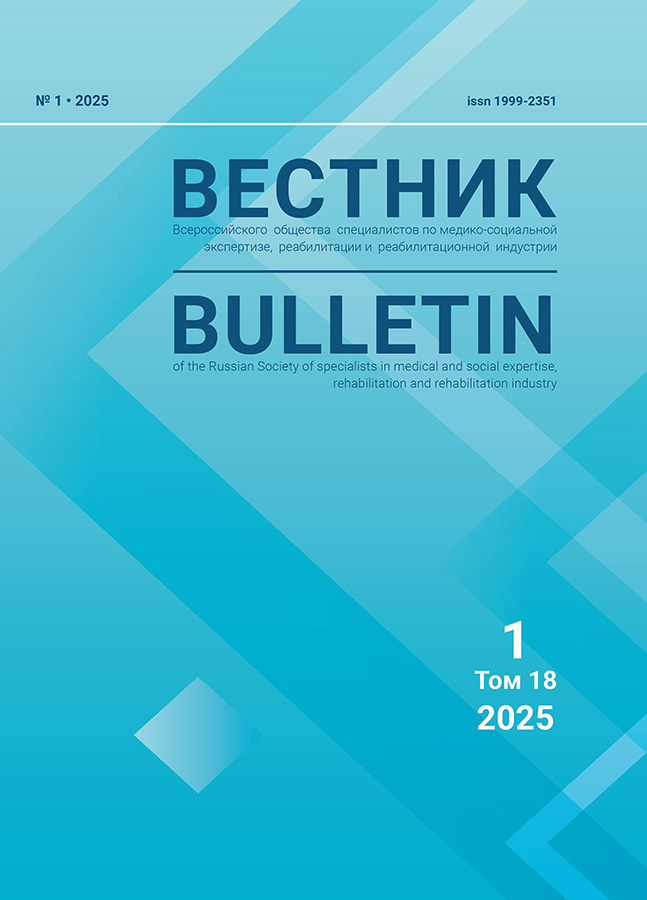Evaluation of the effectiveness of rehabilitation measures in the early recovery period of stroke
- 作者: Mukhortov S.S.1, Verikovsky V.A.1, Yesaulenko I.E.2, Myachina O.V.2
-
隶属关系:
- Voronezh Regional Clinical Hospital No. 1
- Federal State Budgetary Educational Institution of Higher Education «N.N. Burdenko Voronezh State Medical University» of the Ministry of Healthcare of the Russian Federation
- 期: 卷 18, 编号 1 (2025)
- 页面: 60-66
- 栏目: The questions of organization of medical-social expertise and complex rehabilitation
- ##submission.dateSubmitted##: 14.09.2025
- URL: https://jdigitaldiagnostics.com/1999-2351/article/view/690359
- DOI: https://doi.org/10.63839/19992351-06
- ID: 690359
如何引用文章
详细
The influence of many factors on the recovery process after an ischemic stroke is constantly being studied, therefore, the assessment of the impact of the condition of patients in the acute period of stroke on the effectiveness of rehabilitation in the early recovery period was the subject of our study. The medical histories of 36 patients who received a course of medical rehabilitation for patients with impaired central nervous system function were analyzed. It was found that the age of patients, the size of the lesion, the assessment on the stroke severity of the National Institutes of Health Stroke Scale upon admission and discharge during the acute period of the disease, the prescription of the onset of the disease in the early recovery period had correlations with the status of the patient in the early recovery period when evaluated on different scales. Assessment of the objective status of the patient in the acute period of stroke makes it possible to predict his condition in the early recovery period of stroke. The initial status of the patient at the beginning of the disease has a direct effect on the patient's condition in the early recovery period, but practically does not affect the effectiveness of rehabilitation. In our opinion, this may be due to an individual approach in setting rehabilitation goals and drawing up rehabilitation programs by specialists of a multidisciplinary rehabilitation team.
全文:
作者简介
Semеn Mukhortov
Voronezh Regional Clinical Hospital No. 1
编辑信件的主要联系方式.
Email: mukhortov.doc@mail.ru
physiotherapy doctor, neurological department for patients with impaired cerebral circulation
俄罗斯联邦, VoronezhViktor Verikovsky
Voronezh Regional Clinical Hospital No. 1
Email: mukhortov.doc@mail.ru
Candidate of Sciences, Chief Physician, neurological department for patients with impaired cerebral circulation
俄罗斯联邦, VoronezhIgor Yesaulenko
Federal State Budgetary Educational Institution of Higher Education «N.N. Burdenko Voronezh State Medical University» of the Ministry of Healthcare of the Russian Federation
Email: mukhortov.doc@mail.ru
Doctor of Science, Professor, Rector
俄罗斯联邦, VoronezhOlga Myachina
Federal State Budgetary Educational Institution of Higher Education «N.N. Burdenko Voronezh State Medical University» of the Ministry of Healthcare of the Russian Federation
Email: Olga_V_Myachina@mail.ru
Doctor of Science, Associate Professor, Head of Biology Department
俄罗斯联邦, Voronezh参考
- Gusev V.V., Lvova O.А., Kovtun O.P et al. «The options for prognosis of the outcome of ischemic stroke in young patients» // Perm Medical Journal. 2024. Vol. 41. N. 2. 87-95 pp. (In Russ.).
- Mel'nikova EA, Razumov AN. «The factors influencing the recovery of the patients suffering from stroke during the rehabilitation period» // Problems of Balneology, Physiotherapy and Exercise Therapy. 2015. Vol. 92. N. 5. 4-11 pp. (In Russ.)
- Razumov A.N., Melnikova E.A. «The main indicators of rehabilitation prognosis in stroke patients» // Doctor.Ru. 2016, N. 12 (129). Part II. 16-22 pp. (In Russ.)
- Smychkov A.S., Zarubina T.V., Skvortsova V.I. «Prediction of the acute period of hemispheric ischemic stroke according to electroencephalography using the binary logistic regression method» // Bulletin of RSMU. 2010. № 4. (In Russ.). URL https://cyberleninka.ru/article/n/prognozirovanie-ostrogo-perioda-polusharnogo-ishemicheskogo-insulta-po-dannym-elektroentsefalografii-s-ispolzovaniem-metoda-binarnoy (date of application: 15.04.2024).
- Sumin A.N., Kоlmykova Yu.A., Kukhareva I.N., Ott M.V. et al. «Annual prognosis in patients with acute cerebrovascular accident: the role of the pathological ankle-shoulder index» // Rational Pharmacotherapy in Cardiology. 2016. No.6. (In Russ.). URL https://cyberleninka.ru/article/n/godovoy-prognoz-u-bolnyh-s-ostrym-narusheniem-mozgovogo-krovoobrascheniya-rol-patologicheskogo-lodyzhechno-plechevogo-indeksa (date of application: 15.04.2024).
- Anjos J.M., Neto M.G., de Araújo Tapparelli Y. et al. «Efficacy and safety of very early mobilization after thrombolysis in acute ischemic stroke: a randomized clinical trial» // J. Neurol. 2023. Vol. 270, № 2. P. 843-850.
- Ikeme S., Kottenmeier E., Uzochukwu G., Brinjikji W. «Evidence-Based Disparities in Stroke Care Metrics and Outcomes in the United States: A Systematic Review» // Stroke. 2022. Vol. 53, № 3. P. 670-679.
- Jeffares I. «Rehabilitation for Cognitive Impairment after Stroke: Exploration of Possibilities for the Delivery of Cognitive Rehabilitation» // Diss. – Royal College of Surgeons in Ireland, 2022.
- Li T., Ye M., Yang G. et al. «Regional white matter hyperintensity volume predicts persistent cognitive impairment in acute lacunar infarct patients» // Front Neurol. 2023. Vol.10. P. 14:1265743.
- Lima F.O., Furie K.L., Silva G.S. et al. «Prognosis of untreated strokes due to anterior circulation proximal intracranial arterial occlusions detected by use of computed tomography angiography» // JAMA Neurol. 2014. Vol. 71(2). P. 151-157.
- Ryu J.S., Lee J.W., Lee S.I., Chun M.H. «Factors predictive of spasticity and their effects on motor recovery and functional outcomes in stroke patients» // Top Stroke Rehabil. 2010. Vol.17(5). P. 380-3888.
- Ueda T., Sakaki S., Kumon Y., Ohta S. «Multivariable analysis of predictive factors related to outcome at 6 months after intra-arterial thrombolysis for acute ischemic stroke» // Stroke. 1999. Vol. 30(11). P. 2360-2365.
- Wang, Chung-Yuan et al. «Walking ability and functional status after post-acute care for stroke rehabilitation in different age groups: a prospective study based on propensity score matching» // Aging. 2020. Vol. 12 (11). P.10704-10714.
- Wu J., Zhang J., Bai Z. et al. «Predictive factors of upper limb motor recovery for stroke survivors admitted to a rehabilitation program» // Eur J. Phys Rehabil Med. 2020. Vol. 56(6). P. 706-712.
- Yoo J.W., Hong B.Y., Jo L. et al. «Effects of Age on Long-Term Functional Recovery in Patients with Stroke» // Medicina. 2020. Vol. 56(9). P. 451.
补充文件








